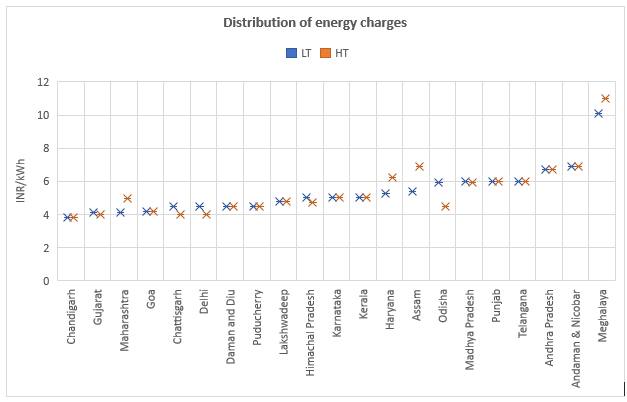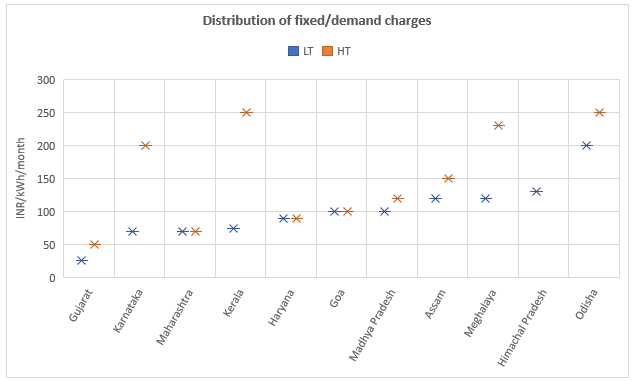What is the cost of charging electric vehicles?
Electric vehicles (EV) run on batteries which need electricity for charging. The power distribution companies (discoms) in India are responsible for the last mile delivery of electricity to end-users at a rate (tariff) which is set by the State Electricity Regulatory Commissions (SERCs). The Electricity Act 2003 provides wide flexibility to the SERCs in determining the tariffs which discoms charge their end-users. The tariffs can be differentiated on the basis of type of consumers, consumers’ load factor, time of the day, voltage, geographical location, etc.1
From the implementation viewpoint, currently there are about 20+ states which have identified EV charging as a separate consumer category. In some states, they are introduced as an altogether new consumer category, while in a few others, they are included among non-domestic or commercial category consumers. Typically, the tariff that a consumer with an EV connection (such as a driver charging at home or charge point operator) pays for charging their EVs is composed of the following components:
Source: CEEW-CEF analysis8
Relevance and impact
Figure 1 depicts the states with specified tariffs for EV charging. As depicted in Figure 2, for most of the states, energy charges for EV charging lies between INR 4/kWh and INR 6/kWh. A few states also have an additional fixed/demand charge which varies from INR 50/kWh/month to INR 250/kWh/month for HT consumers, and from INR 25/kWh/month to INR 200/kWh/ month per installation for LT consumers9, as depicted in Figure 3. Furthermore, a few states have specific time-of-day surcharge or rebates for EV charging. The surcharge or rebates varies with season and on the basis of peak and non-peak hours of the day.10
Figure 1 – Applicability of various charges for EV charging across Indian states.
Source: CEEW-CEF Analysis
Note: for Chandigarh, Andaman & Nicobar, Daman & Diu, Lakshadweep, and Puducherry, only energy charge is levied
As a consumer class, EVs are an important grid resource. EV charging is a source of additional electricity demand for discoms. It also determines the total cost of ownership of an EV. Given its linkages with the entire value chain for EVs, tariffs play an important and influential role in determining the adoption of EVs. It is notable that, to encourage EV adoption, a number of state governments have purposely rolled out low EV tariffs as it keeps the cost of EV charging low for consumers.
Who should care?
- EV owners
- Prospective EV buyers
- Charge point operators
- Distribution companies
Annexure
Figure 2 – Distribution of energy charges

Source: CEEW-CEF analysis based on tariff orders of the states.
Note: Two states having more complex structures for energy tariffs are mentioned separately in this footnote. In Jharkhand, the energy charges for rural and urban consumers are INR 5.75/kWh and INR 6.0/kWh respectively. In UP, the energy charge for LT consumers ranges between INR 6.2/kWh and INR 7.7/kWh, while for HT consumers, it ranges between INR 5.9/kWh and INR 7.3/kWh.
Figure 3- Distribution of fixed/demand charges
 Source: CEEW-CEF analysis based on tariff orders of the states.
Source: CEEW-CEF analysis based on tariff orders of the states.
Note: The state of Jharkhand has a different structure for fixed charges. In Jharkhand, the demand charges for rural and urban consumers lie between INR 50/kWh/month and INR 100/kWh/month respectively.
References
- [1] Section 62(3).
- [2] The battery size of Tata Nexon EV is 30.2 kWh and the energy charge for EV charging in Delhi is between INR 4/kWh and INR 4.5/kWh.
- [3]LT (Low tension) line refers to the low voltage line while a HT (High tension) line refers to the high voltage line. In India, the voltage capacity of a LT line ranges from 400 volts for a 3-phase connection to 230 volts for a single-phase connection, while the voltage capacity of a HT line is about 11,000 volts and above.
- [4] KERC.2020. “Electricity Tariff – 2021.” https://bescom.karnataka.gov.in/storage/pdf-files/RA%20section/Tariff%20Order%202020%20Rates.pdf. Accessed 05 August, 2021.
- [5] DERC. 2020. “Electricity Tariff Schedule for FY 2020-21 – BRPL, BYPL, TPDDL & NDMC.” http://www.derc.gov.in/sites/default/files/Tariff%20Schedule%202020-21.pdf, Accessed 05 August, 2021.
- [6] DERC. 2020. “Electricity Tariff Schedule for FY 2020-21 – BRPL, BYPL, TPDDL & NDMC.” http://www.derc.gov.in/sites/default/files/Tariff%20Schedule%202020-21.pdf, Accessed 05 August, 2021
- [7] Bijli Bachao. “Tax and duty on Electricity Bills in India.” https://www.bijlibachao.com/electricity-bill/electricity-duty-and-tax-on-electricity-bills-in-india.html. Accessed 05 August, 2021.
- [8] Maheshwari, Sidhartha and Meghna Nair. 2021. “Laying the Groundwork for Electric Vehicle Roaming in India: Interoperability of Electric Vehicle Charging.” CEEW-EDRV Report. New Delhi: Council on Energy, Environment and Water.
- [9] Based on the tariff orders for Uttar Pradesh (2019) and Chandigarh (2020).
- [10] Based on analysis of the tariff orders of the states.



